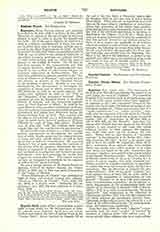

Regulars (Lat. regula, rule).—The observance of the Rule of St. Benedict procured for the monks at an early period the name of “regulars”. The Council of Verneuil (755) so refers to them in its third canon, and in its eleventh canon speaks of the “ordo regularis” as opposed to the “ordo canonicus”, formed by the canons who lived under the bishop according to the canonical regulations. There was question also of a “regula canonicorum”, or “regula canonica”, especially after the extension of the rule which St. Chrodegang, Bishop of Metz, had drawn up from the sacred canons (766) [cf. capitularies (n. 69 circa 810, n. 138 of 818, 819, ed. Alf. Boretii)]. And when the canons were divided into two classes in the eleventh century, it was natural to call those who added religious poverty to their common life regulars, and those who gave up the common life seculars. Before this we find mention of “saeculares canonici” in the Chronicle of St. Bertin (821) (Marten, Anecdot., III, 505). In fact as the monks were said to leave the world (St. Augustine, Serm. 49 de div.), sometimes those persons who were neither clerics nor monks were called seculars, as at times were clerics not bound by the rule. Sometimes also the name “regulars” was applied to the canons regular to distinguish them from monks. Thus the collection of Gratian (about 1139), C. xix, q. 2, c. 2 and q. 3, c. 1, speaks of canons regular, who make canonical profession, and live in a regular canonicate, in opposition to monks who wear the monastic habit, and live in a monastery. But the Decretals of Gregory IX, promulgated September 5, 1234, use the word “regularis” in a more general sense, in book III, ch. xxxi, which is entitled “De regularibus et transeuntibus ad religionem”. However in ch. xxxv “De statu monachorum et canonicorum regularium” the distinction returns, disappearing in the corresponding book and chapter of the Decretals of Boniface VIII (March 3, 1298), t. XVI, in 6, which is entitled merely “De statu regularium” and reappearing in the collection of Clementines (October 25, 1317) but with the conjunction eel, which indicates the resemblance between them. (Although another edition has et, the title of ch. x, c. 3 Clem. in the official edition reads “De statu monaehorum, vel canonicorum regularium”.)
From that time, while the word “religious” is more generally used, the word “regular” is reserved for members of religious orders with solemn vows. It means strictly those religious who have made solemn profession. Those who have taken simple vows in the Society of Jesus are also regulars in the proper sense according to the Constitution “Ascendente” of Gregory XIII. Writers are not all agreed on the question whether the religious of other orders can properly be called regulars before solemn profession. The novices of religious orders are regulars only in the wider meaning of the word.
A. VERMEERSCH

